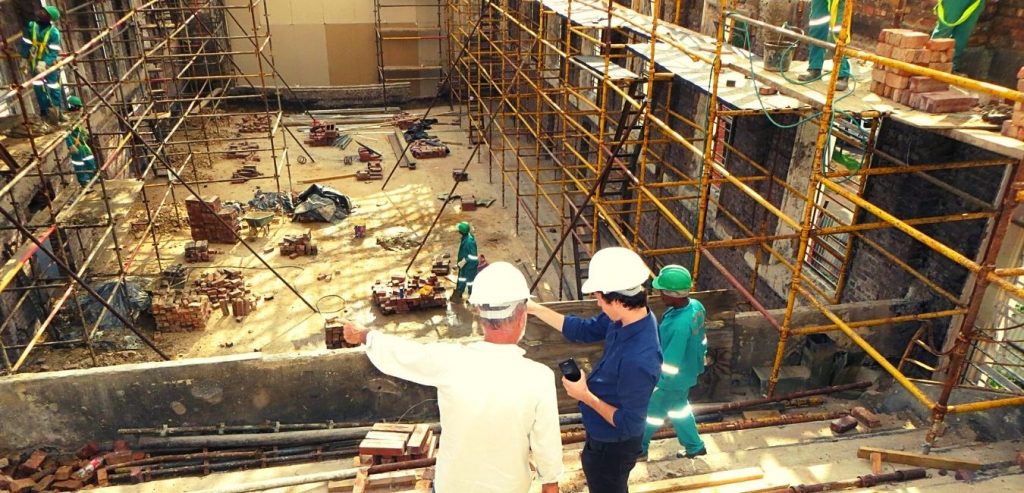No two construction projects are alike, and there is a need to have different construction contracts to meet all the involved parties’ needs. Having the ideal arrangement for a project helps contractors, clients, and project managers properly manage the risk and ensure that everything runs as smoothly as possible.
Table of Contents
What is a construction contract?
A construction contract is a legally binding agreement between the owner and the contractor that states a given job will receive the proper compensation. The contract outlines the terms and conditions of the agreement, rights, and duties of all the involved parties, the commencement date of the work, and the expected completion date. The contract also denotes how the compensation will be distributed. Even if both parties “trust” each other, it is vital to have a construction contract, as we will see below.
Benefits of a construction contract
Construction projects, by their nature, are complicated. However, it is essential to enter a contract as there are significant economic transactions involved. Construction contracts are generally in written form as this ensures that the parties involved comply with the reasonable business procedures as spelled out in the contract. A well-written construction contract is essential because of the following reasons: –
It meets the default provisions of the law
The provisions of the law state that a contract, whether written or oral, should be in place to control the handling of issues in case conflict arises. Having well-defined contract terms ensures that unfavorable default terms are not imposed on projects in the case of a dispute.
Shifting risk
The provisions in a contract continually shift some identifiable risks from the owner to the project’s builder. There are numerous significant risk issues apart from the price that both parties may allocate to a contract. However, the contract also does not need to shift the risk to one party entirely. Other risk issues include regulatory risks, design issues, time, funding, indemnities, and acts of God. The contract, therefore, protects the rights of the client and contractor.
A contract leads to a more complete and satisfactory structure
The contract method ensures that the construction plans are detailed and comprehensive. It prevents costly mistakes and ensures that the project meets the owner’s goals accordingly. Construction contracts also ensure that the whole project team works in the same direction to attain the same goal.

The three critical types of construction contracts
The disbursement of funds usually defines construction contracts. However, the contract types also detail other specific terms like quality, duration, specifications, and other items. Having the best contract type for your project ensures the best delivery outcome, client satisfaction, and profits. There are three major construction contracts that every builder ought to know about.
Lump-sum contracts
Lump-sum contracts have a total fixed price for all the activities involved in the project. It may also include the benefits and incentives for the early termination of the project. Lump-sum contracts usually are used when the owner wants to shift all the risk to the contractor and avoid the change orders for unspecified tasks in the project.
The contractor, therefore, takes on additional risk as the owner has no obligation to pay more when the project stretches beyond the scope. Some lumpsum contracts consider this in calculation by having separate allowances that have unforeseen costs and changes.
An excellent example of a lumpsum contract may be during constructing a residential tower where the client agrees to a fixed price contract.
There are high odds that most contractors have been in lumpsum contracts severally. As simple as lumpsum contracts seem, they have clear advantages and drawbacks.
Pros of lumpsum contracts
When the scope of a project is clearly defined, the contractor can estimate the contract prices accurately. Other advantages of lumpsum contracts are: –
- It reduces the client’s risk as the price is fixed.
- The bidding and selection process is easy and straightforward as only one sum is submitted.
- There are minimal change orders.
- There is ease and certainty by a client when securing construction loans.
- Finishing under budget assures higher profit margins by the contractor.
Cons of lumpsum contracts
Contractors carry most of the risk involved in lumpsum contracts. Some of the disadvantages of these contracts are: –
- It gives greater risk to the contractor
- Due to the additional risk, contractors increase their tender prices
- The tendering process may be slower than in other contract forms as the contractor uses more time in preparing the tender.
- Disputes can quickly arise on matters such as scope, design changes, and change orders.

Re-measurement contracts
A re-measurement contract is whereby work done is measured then valued against the agreed rates. Unlike in lumpsum contracts, there is no agreement to a lump sum, but the terms are based on the work done. These contracts are also known as unit price contracts or measure and pay contracts.
An example of a re-measurement contract may be in constructing a highway where the price is given per kilometer based on the length built and the final length of the project. This contract is applied in extensive infrastructure and public works projects where the resources are easy to quantify. Another example is in excavation work. It may not be easy to estimate the scope of work until actual excavation commences.
Pros of re-measurement contracts
Re-measurement contracts are advantageous for work where work depends on the default rates. These contracts are also used to have a flexible budget and may want to improve the design progressively. Other advantages include: –
- Lower risks for the contractor
- Easy and quick bidding processes
- Competitive unit prices
- Reduced design costs
Cons of re-measurement contracts
Re-measurement contracts are not always a good fit for projects with a lot of materials and tasks. Other disadvantages include: –
- They cannot predict the total cost of the project
- The client’s risk is usually high
- Controlling and reporting usually is difficult in these projects
- There typically are delays in contractor payments in this contract type
Reimbursement contracts
This contract type is where the project owner reimburses the contractor for the costs incurred after carrying out the work with an additional fee. This contract applies where the scope of work is unclear from the outset, and the associated risks are high. This contract is also called a cost-plus fee contract.
Federal government agencies, particularly defense agencies, use this kind of contract in construction. For instance, you may have a project where you want to extend your office space, but you don’t know the scope of work involved. Therefore, you may get in a reimbursement contract with your contractor to assist you in monitoring the cost appropriately even with the uncertainty in scope.
Pros of reimbursement contracts
In this contract, the project owner compensates the builder for the working fees plus a fixed fee representative of the work. This contract type has several advantages as follows: –
- Higher work quality as the contractor is free to use the best labor and materials at his disposal.
- There is a lower chance of overbids on the project.
- It is cheaper than fixed-price contracts because of the lower risks on the contractor’s side.
- It allows for project completion even when there are unknown situations at hand.
- There is more flexibility in decision-making.
Cons of reimbursement contracts
Due to the uncertainty in the scope of work, cost-reimbursement contracts have some limitations. Some of the disadvantages are as discussed below: –
- It is challenging to compute a final project estimate.
- It needs more oversight for effectiveness.
- There are restrictions on the scope of the projects under this contract. For instance, in 2006, Australia mandated that all domestic building projects be fixed-price contracts.
- This contract forces owners to take up most of the risk.
Other construction contract types
Other than the main contract types mentioned above, we have other construction contracts for special conditions. One of them is a GMP contract.
GMP contracts
These are known as Guaranteed maximum price contracts. They establish a maximum price beyond which the owner won’t be liable for the expenses incurred. Other contracts, such as reimbursement contracts, may also have GMP provisions to curtail the costs to a maximum. They are suitable for projects with undefined scope. An example is the construction of a retail chain that has plans used over and over.
Pros of GMP contracts
- Having a final price accelerates projects because of a quicker bidding process.
- Contractors can incentivize savings
Cons of GMP contracts
- GMP contracts place a lot of risks on contractors.
- They take longer to review by the contractors because of the risk exposure.

What to include in a construction contract
When drafting a construction contract, the arrangement of work should be precise. A detailed and coherent construction contract minimizes the confusion and clarifies all the duties and responsibilities of the involved parties. A construction contract should address the following key points: –
Base date
The base date refers to a reference date from when changes in contract conditions can be evaluated. It is a risk allocation mechanism between the client and contractor. It caters to any contract changes from the pricing of the tender to the actual signing of the tender. This timeframe in small projects is minimal, and therefore the base date is considered unnecessary. Traditionally the base date was the tender date, but due to uncertainties in the tender process, it is now linked to the date of the return of tenders.
Practical completion
This is a contractual term that signifies the date the project is handed over to the client. It is the point the project is complete except for some minor defects that can be rectified without interference to the occupant. Some contracts do not define practical completion but leave it open to the professional judgment of the architect or contract administrator. The minor defects are dealt with by the architect or project administrator by issuing a snagging list.
Retention
Retention refers to a certified amount deducted from the contractor on the interim certificate but is retained by the client. The purpose of the retention is to ensure the contractor completes the contract activities correctly.
Sectional completion
This provision of construction contracts allows for different completion dates on various sections of the project. It is prevalent for large projects as it enables the client to occupy the completed parts as construction is ongoing. When required in a contract, it has to be stated expressly, and the extent and completion of each section are clearly stated.
Snagging
Snagging is a slang term used in construction to define the inspection necessary for compiling minor defects or omissions that the contractor needs to rectify in a project. Typically, the architect or contract administrator prepares a snagging list that is issued to the contractor. The list contains faults that need rectification before the issuance of the certificate of completion.
Construction Agreement
A construction agreement is a document that sets the foundation for the rest of the project details. It indicates the general purpose of the contract as well as the price of the contract. It can be customized to suit the specific needs of a project. Others can be standard. Within this agreement, the contract payment setup determines how long the construction agreement document will be.
Scope of work definition
The scope of work refers to the general description of all the work expected under the construction contract. It shows the services that should be provided, the materials and their quantity, quality, and the project schedule. In the construction contract, the work scope must be clearly defined, showing the tasks, duties, and limitations to avoid any loopholes and liabilities.
General conditions
These are answers to how payment applications are processed, how disputes are resolved, and how the change orders are submitted. The general conditions highlight all the rights and obligations of the parties involved.
Special conditions
These elaborate on the requirements and instructions for the construction work. The special conditions are an advancement of the general conditions. They include the individual tasks of the whole project.
Bill of quantities
This document creates part of the construction contract agreement. It highlights the prices and the quantities for each activity to be done. All the work is listed for a detailed view of the tasks.
Work schedule
A roadmap of how and when the tasks will be done is mandatory for any project. The work schedule will include the project duration, the milestones to be met at the beginning and end of a project, the delivery date, and other timings. All tasks and subtasks are noted against a time frame, with some being merged or grouped as they may be complementary.
Drawings
Drawings are essential as an attachment in the contract agreement to show quantities, sizes, locations, dimensions, shapes, and other elements. The drawings can be statistical, electrical, mechanical, architectural, landscape, and others which have information on the whole project.
Technical specifications
The materials, workforce, and equipment needed describe the end product. Each task should be noted, and the deviation limits should be determined in technical specifications.
Contract negotiations
Negotiation aid in forming a solid relationship between the contractor and the client. Aspects of the contract that need negotiation are:
Contract Sum and Payments
This is the price the contractor agrees upon before entering the contract. Negotiation, in this case, is done to consider factors that affect the contractor’s pricing. These factors are losses, inflation, fluctuations, variations, and other statutory fees. The negotiation leads to an agreement on what can be saved and used within the project.
Scope of Work
This brings out the milestones, deliverables, timelines of work, and the end project marks. In the negotiation process of this section, the conditions, assumptions, specifics, and plans of the scope of work are discussed in depth. Should there be the need for more compensation in the increase of time, such terms should be negotiated.
Risk allocation
Parties should discuss the unprecedented risks expected in the contract. This is likely to include the case of unexpected site conditions, some indemnity clauses on the risk of property damage, physical injury, and insurance clauses. Negotiation is done to allow all parties to agree upon the risks arising and settlement options.
Timing and Schedule of Project
The schedule of the project determines the payment dates. This negotiation should ensure that the parties involved agree on the timing as per the scope of work and the payment dates and compensation changes.
Contract Language
There is a common language used in construction contracts. This include:
- Owner: This refers to the company or individual hiring or entering the construction contract.
- General Contractor: They oversee the process of construction and manage the employees.
- License number:This is a number by the state to the general contractor licensing them to work and provide services legally.
- Job site: Refers to the physical location or address where the construction work is to be done.
- Contract Documents: Blueprints, drawings, designs, and exhibits of the work to be done.
- Description of work: Specifications of the scope of work and personnel to do it.
- Timeline: The start, end date, and milestones for the project.
- Labor and materials: The personnel needed to procure the materials for use in the project and their costs.
- Price and payments: Refer to the cost of the work outlined in the contract with their payment terms.
- Change requests: The communication outline of how changes and the fees attracting change orders will be made to the general contractor.
- Licencing and permits: This shows who is responsible for requesting and getting the licenses and permits to complete the work outlined in the contract.
- Termination: Indicates the penalties to be incurred when either party terminates the contract.
- Inspection: What the project owner should use to look into the completed work as per the construction contract.
Construction contract resources
Detailed construction contracts make the construction process run smoothly. In addition, powerful tools such as Proest software help you manage projects from inception to completion.
You can use in-built Gantt charts to plan your projects and add tasks linking them across the overall timeline.
You can also use cloud-based resource management software that gives real-time data on your resources and teams. You can also add hourly rates, planned costs, and actual costs.You can also use Excel Timesheets with time-tracking features that update automatically on task completion. In addition, you can track progress in real-time on the charts.
Construction contract templates
Creating a construction contract with every new project can be very tedious, and that is why it is essential to have a standardized template with standard project parameters. The templates can then further undergo modification to meet specific project requirements. ConsensusDocs, Autodesk, and the American Institute of Architects have standardized contract documents that come in many varieties to suit project needs. A good contract is beneficial to all the involved parties, and such standardized templates give you peace of mind that other construction parties adhere to the same provisions as you are.
Frequently asked questions
Construction contracts have severe implications for your liabilities and rights. Below are the frequently asked questions that help you properly understand what you need to know about construction constructs.
How do I get construction contracts?
Getting construction contracts is not the most exciting part of a business, but it is vital since it is the difference between one-off jobs and major contract jobs. You can get construction contracts through construction bidding sites that give you unique services to plan and cost jobs.
What other documents should be with the construction contract?
The construction contract is not limited to a single document. It includes schedules, specifications, drawings, and a value of schedules.
What happens if I make a mistake on the contract?
Mistakes can be very costly, depending on whether it is a mutual or a unilateral mistake. Some mistakes may be minor and easy to modify, but others may need the rescission of the entire contract.
Conclusion
Understanding the different construction types helps you determine the best construction type for you. Not only are there a variety of contracts to choose from, but there are also options within the contract. Always look out for problematic clauses and plausible risks before signing a contract.

